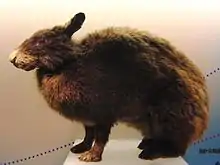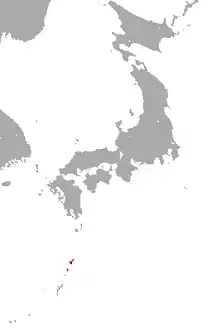Amami rabbit
The Amami rabbit (Pentalagus furnessi; Amami: [ʔosaɡi]), or Amamino kuro usagi (アマミノクロウサギ 奄美野黒兔, lit. "Amami wild black rabbit"), also known as the Ryukyu rabbit is a dark-furred rabbit which is only found in Amami Ōshima and Toku-no-Shima, two small islands between southern Kyūshū and Okinawa in Kagoshima Prefecture (but actually closer to Okinawa) in Japan. Often called a living fossil, the Amami rabbit is a living remnant of ancient rabbits that once lived on the Asian mainland, where they died out, remaining only on the two small Japanese islands where they live today.[3]
| Amami rabbit[1] | |
|---|---|
 | |
| Taxidermy specimen at the National Museum of Nature and Science in Tokyo, Japan. | |
| Scientific classification | |
| Kingdom: | Animalia |
| Phylum: | Chordata |
| Class: | Mammalia |
| Order: | Lagomorpha |
| Family: | Leporidae |
| Genus: | Pentalagus Lyon, 1904 |
| Species: | P. furnessi |
| Binomial name | |
| Pentalagus furnessi (Stone, 1900) | |
 | |
| Amami rabbit range | |
Evolution
Pentalagus is thought to be a descendant of Pliopentalagus, known from the Pliocene of China and Eastern to Central Europe.[4]
Biology
Diet
The amami rabbit feeds on over 29 species of plants, which incorporates 17 species of shrubs and 12 species of herbaceous plants, consuming mostly the sprouts, young shoots and acorns.[5] It also eats nuts and cambium of a wide variety of plant species.[6] It is observed that the amami rabbit also feeds on the bark of stems and twigs of shrub plants.[6] During summer, the amami rabbit primarily feeds on Japanese pampas grass, and during winter, they primarily eat the acorns of the pasania tree.[7]
Morphology
The Amami rabbit has short feet and hind legs, a somewhat bulky body, and rather large and curved claws used for digging and sometimes climbing.[8] Its ears are significantly smaller compared to those of other hares or rabbits.[9] The pelage is thick, wooly and dark, brown on top and becomes more reddish-brown on the sides.[10] It has heavy, long and very strong claws, being nearly straight on the forefeet and curved on the hindfeet [10] The eyes are also small compared to more common rabbits and hares. The average weight is 2.5–2.8 kg.[11]
Distribution and habitat
The ideal habitat for these rabbits is in an area between mature and young forests.[12] They use the dense mature forests as protection and for the presence of pampas grass, in the summer, and acorns, in the winter, for their diets.[13] They also use the high density of perennial grasses and herbaceous ground cover in the young forests for their diets during different times of the year.[14][15] Therefore, the best habitat for them to live in is where they have easy access to both young and mature forests with no obstructions between the two forest types.[16]
Using fecal pellet counts and resident surveys, the number of rabbits is estimated at 2000–4800 left on Amami Island and 120–300 left on Tokuno Island.[12]
Behavior
This species is a nocturnal forest-dweller that reproduces once in late March–May and once in September–December, having one or two young each time.[14] During the day, the mother digs a hole in the ground, for her young to hide in. At night, she opens the entrance to the hole, while watching for predators (such as venomous snakes), and then nurses her young, after which she closes the hole with soil and plant material by thumping on it with her front paws.[17] Amami rabbits sleep during the day in hidden locations, such as caves.[18] They are also noted for having a call similar to that of a pika.[11]
Endangered species
Threats
Before 1921, hunting and trapping were another cause of decline in population numbers. In 1921, Japan declared the Amami rabbit a "natural monument" which prevented it from being hunted.[10] Then in 1963, it was changed to a "special natural monument" which prevented it from being trapped as well.[16]
Habitat destruction, such as forest clearing for commercial logging, agriculture space, and residential areas, is the most detrimental activity on the distribution of these rabbits.[19] Since they prefer a habitat of both mature and young forests, they do not thrive in only mature forests untouched by destruction, yet they do not thrive in newly growing forests alone, either.[16] There are plans to remove current habitat for these rabbits for the construction of golf courses and resorts, which is allowed because it will not directly be killing the rabbit, just changing the environment where it dwells, which is legal even under the protection of the special natural monument status.[20]
The Amami rabbit also faces huge threats from the invasive predators, being a major cause for the decline in population size.[14] On the island of Amami, the small Indian mongoose (Herpestes javanicus) was released to control the population of a local venomous snake, and its numbers have increased dramatically.[21] This mongoose, along with feral cats and dogs, are outpreying the Amami rabbit.[16] Feral cats and small Indian Mongooses proved to be a threat to not only Amami rabbits but several other endangered endemic species in the area such the Amami jay.[22]
Conservation
In July 2008, the Amami Rangers for nature conservation obtained a photograph of a feral cat carrying a rabbit corpse (rabbit bones and fur found in cat or dog droppings had already been found), prompting discussions on better ways to control pets.[17] A small area of the Amami Island has the Amami Guntō National Park that further protects the population.[23] Some attempt at habitat restoration has been made, but the Amami rabbit needs a mosaic of mature and young forest in close proximity, and when a young forest is regrown nowhere near a mature forest, this rabbit is not likely to inhabit it.[17] Research and population monitoring also is underway to try to keep the numbers from declining, even if they can not be increased.[16]
Suggested conservation work for the future includes habitat restoration and predator population control. A healthy balance of mature and young forests still exists on the southern end of Amami, so that area should be protected. Restricting logging would also help to keep more forest available for the rabbits to live in by leaving more forest standing, as well as disturbing the surrounding environment more.[8] An end to the building of forest roads used for logging and travel would further protect the Amami rabbit, as they cause population and habitat fragmentation, destroys their prime habitat and allows predators easier access to the middle of forests where a majority of the rabbit population exists.[14] Controlling the populations of mongooses, feral dogs, and feral cats is another approach that could help bolster the rabbit population.[8] Eradication of the mongooses and feral cats and dogs is needed, as well as better control of pets by local island residents.[16]
The Lagomorph Specialist Group of the International Union for the Conservation of Nature and Natural Resources proposed a plan of conservation in 1990.[8] In Amami-Oshima Island, the Amami Wildlife Conservation Center of the Ministry of the Environment was established in 1999.[10] It restarted a mongoose eradication program in 2005 and designated the Amami rabbit as endangered in 2004 for Japan.[11]
See also
References
- Hoffman, R.S.; Smith, A.T. (2005). "Order Lagomorpha". In Wilson, D.E.; Reeder, D.M (eds.). Mammal Species of the World: A Taxonomic and Geographic Reference (3rd ed.). Johns Hopkins University Press. p. 206. ISBN 978-0-8018-8221-0. OCLC 62265494.
- Yamada, F; Sugimura, K. (2008). "Pentalagus furnessi". IUCN Red List of Threatened Species. 2008: e.T16559A6063719. doi:10.2305/IUCN.UK.2008.RLTS.T16559A6063719.en. Listed as Endangered (B1ab(ii,iii,v)+2ab(ii,iii,v)
- Robinson, T.; Yang, F. & Harrison, W. (2002). "Chromosome painting refines the history of genome evolution in hares and rabbits (order Lagomorpha)". Cytogenetic and Genome Research. 96 (1–4): 223–227. doi:10.1159/000063034. PMID 12438803. S2CID 19327437.
- Yamada, Fumio (2008), Alves, Paulo C.; Ferrand, Nuno; Hackländer, Klaus (eds.), "A Review of the Biology and Conservation of the Amami Rabbit (Pentalagus furnessi)", Lagomorph Biology, Berlin, Heidelberg: Springer Berlin Heidelberg, pp. 369–377, doi:10.1007/978-3-540-72446-9_25, ISBN 978-3-540-72445-2, retrieved 7 September 2020
- Ohdachi, Satoshi D.; Ishibashi, Yasuyuki; Iwasa, Masahiro A. (2009). The Wild Mammals of Japan. Shoukadoh Book Sellers. ISBN 9784879746269.
- Alves, Paulo C.; Ferrand, Nuno; Hackländer, Klaus (29 December 2007). Lagomorph Biology: Evolution, Ecology, and Conservation. Springer Science & Business Media. ISBN 9783540724469.
- Corporation, Marshall Cavendish (February 1993). Endangered wildlife of the world. Marshall Cavendish.
- Yamada, Fumio; Cervantes, Fernando A. (1 December 2005). "Pentalagus furnessi" (PDF). Mammalian Species. 782: 1–5. doi:10.1644/782.1. ISSN 0076-3519. S2CID 198130448. Archived from the original (PDF) on 15 March 2016. Retrieved 18 June 2017.
- Taylor, Marianne (15 June 2017). The Way of the Hare. Bloomsbury Publishing. ISBN 9781472909909.
- Alves, Paulo C.; Ferrand, Nuno; Hackländer, Klaus (29 December 2007). Lagomorph Biology: Evolution, Ecology, and Conservation. Springer Science & Business Media. ISBN 9783540724469.
- Yamada, F.; Cervantes, F. (2005). "Pentalagus fernessi". Mammalian Species. 782: 1–5. doi:10.1644/782.1.
- "Pentalagus furnessi (Amami rabbit)". Animal Diversity Web. Archived from the original on 4 May 2017. Retrieved 19 June 2017.
- Nowak, Ronald M. (7 April 1999). Walker's Mammals of the World. Johns Hopkins University Press. ISBN 9780801857898.
- "Pentalagus furnessi (Amami Rabbit, Ryukyu Rabbit)". IUCN Red List of Threatened Species. Archived from the original on 11 March 2017. Retrieved 17 June 2017.
- Watari, Yuya; Nishijima, Shota; Fukasawa, Marina; Yamada, Fumio; Abe, Shintaro; Miyashita, Tadashi (2013). "Evaluating the "recovery level" of endangered species without prior information before alien invasion". Ecology and Evolution. 3 (14): 4711–4721. doi:10.1002/ece3.863. ISSN 2045-7758. PMC 3867906. PMID 24363899.
- Sugimura, K.; Sato, S.; Yamado, F.; Abe, S.; Hirakawa, H. & Handa, Y. (2000). "Distribution and abundance of the Amami rabbit Pentalagus furnessi in the Amami and Tokuno Islands, Japan". Oryx. 34 (3): 198–206. doi:10.1046/j.1365-3008.2000.00119.x.
- Dixon, Kristina. Rabbits, Pikas and Dwarf Rabbits. Lulu.com. ISBN 9781105564963.
- redOrbit. "Amami Rabbit - Redorbit". Redorbit. Archived from the original on 19 June 2017. Retrieved 19 June 2017.
- "Rabbits: Habits, Diet & Other Facts". Live Science. Archived from the original on 20 May 2017. Retrieved 17 June 2017.
- Gielen, D.; Kurihara, R. & Moriguchi, Y. (2002). "The Environmental Impacts of Japanese Tourism and Leisure". Journal of Environmental Assessment Policy & Management. 4 (4): 397–424. doi:10.1142/S146433320200111X.
- Hays, W. & Conant, S. (2007). "Biology and Impacts of Pacific Island Invasive Species. 1. A Worldwide Review of Effects of the Small Indian Mongoose, Herpestes javanicus (Carnivora: Herpestidae)" (PDF). Pacific Science. 61: 3–16. doi:10.1353/psc.2007.0006. hdl:10125/22595. S2CID 86338152.
- Shionosaki, K.; Yamada, F.; Ishikawa, T.; Shibata, S. (2015). "Feral cat diet and predation on endangered endemic mammals on a biodiversity hot spot (Amami–Ohshima island, japan)". Wildlife Research. 42 (4): 343–352. doi:10.1071/WR14161. S2CID 84000778.
- Secretariat, International Union for Conservation of Nature and Natural Resources; Parks, International Commission on National (1975). World directory of national parks and other protected areas. IUCN.
